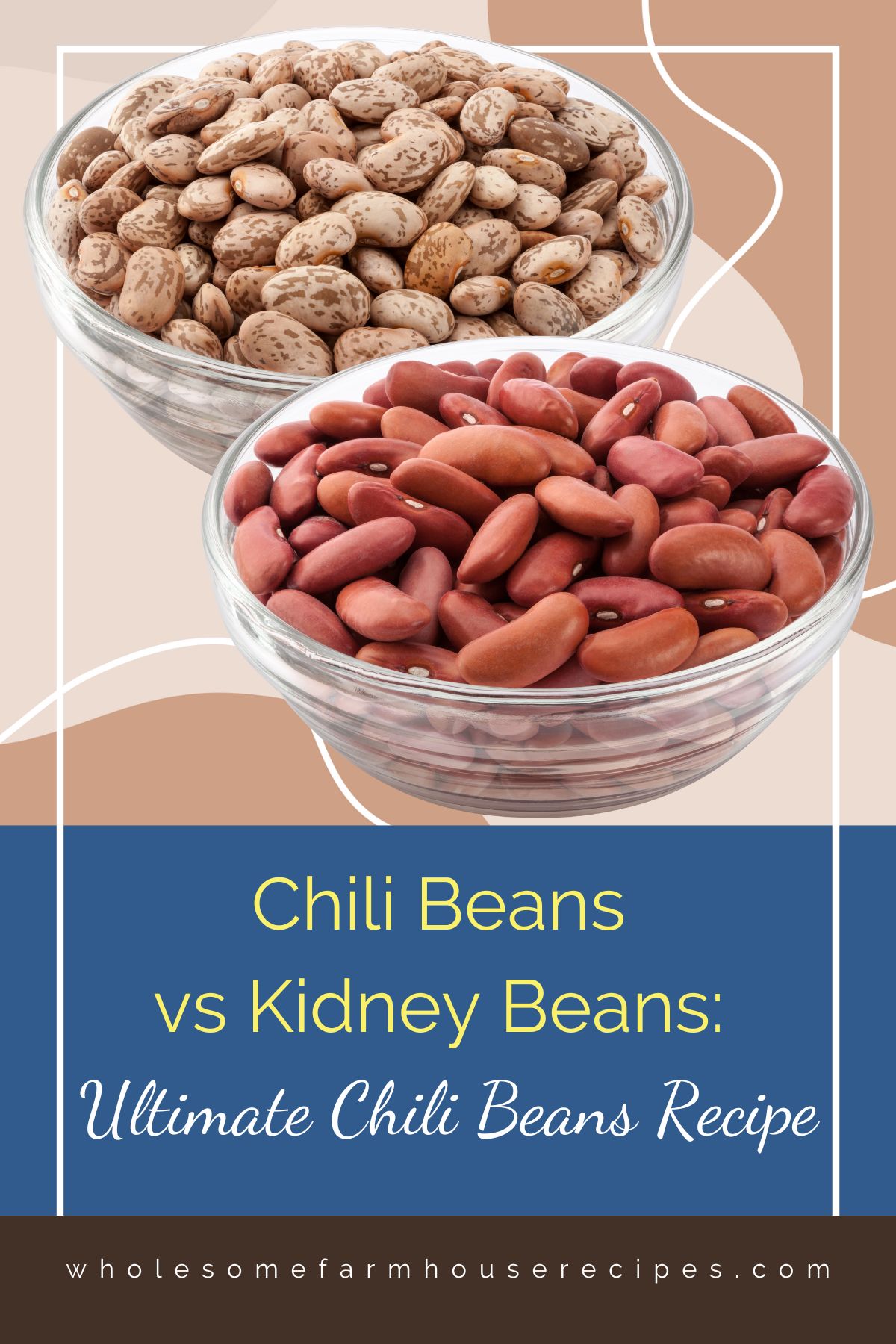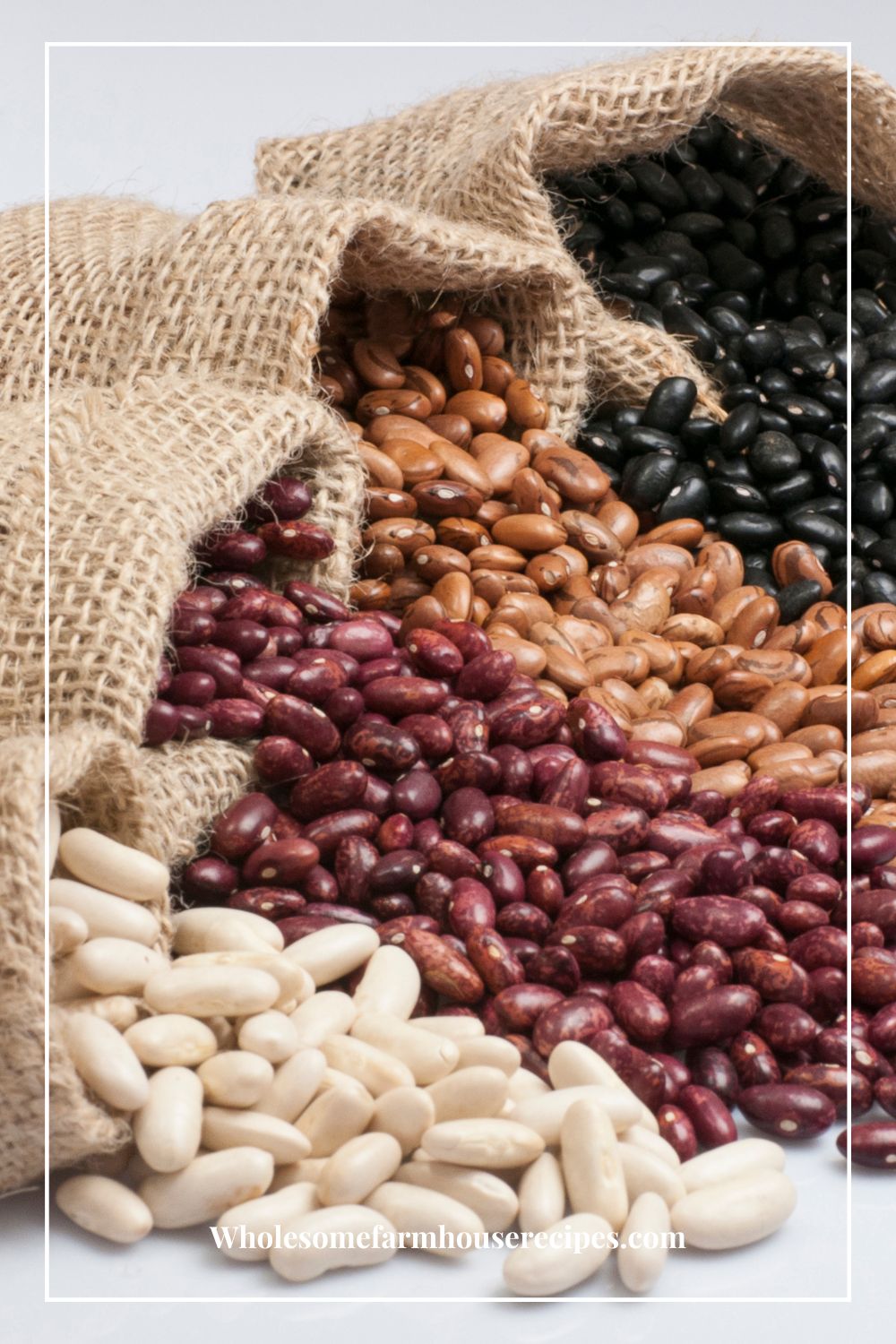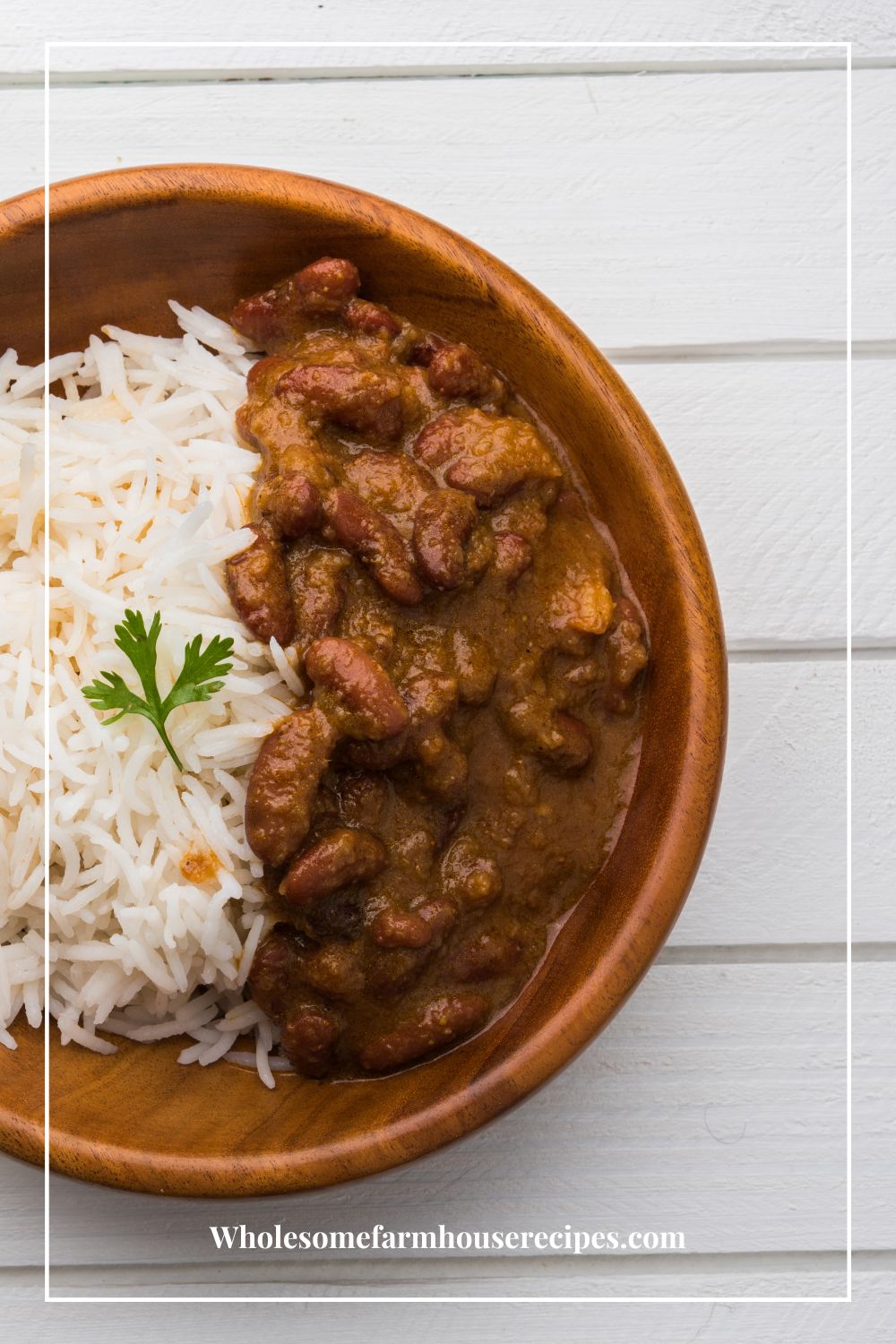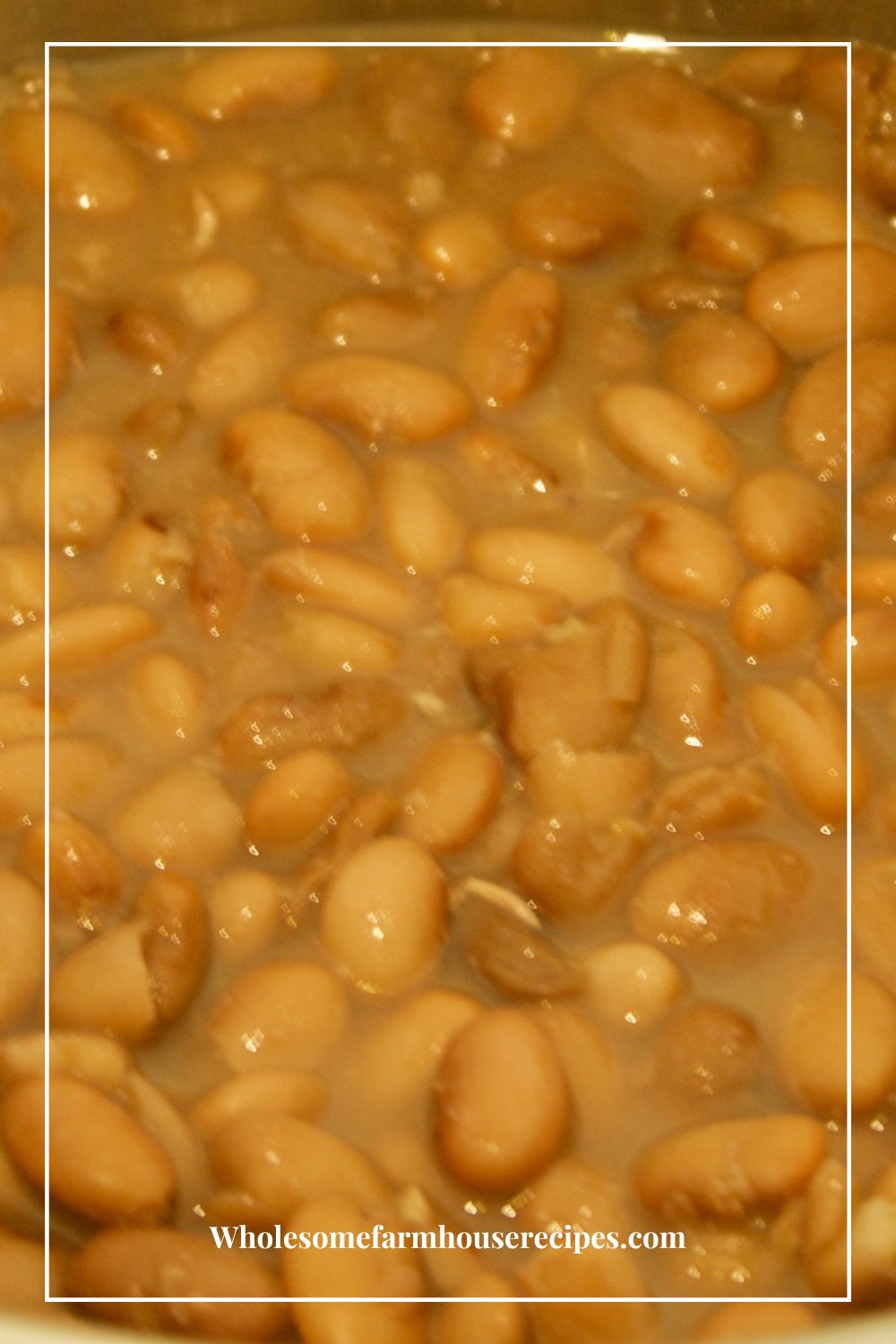Chili beans vs kidney beans. In the colorful world of legumes, there are many types of beans. From small red beans to a wide array of shapes, sizes, and flavors abound, two contenders often find themselves in the spotlight of culinary creativity.
These leguminous powerhouses, with their distinctive appearances and unique textures, have long been staple ingredients in countless dishes. Adding both nutritional value and a hearty dose of flavor to our plates.
But as you stand in the grocery store aisle, pondering your next bean-based masterpiece, you might find yourself grappling with questions.

What sets chili beans and kidney beans apart?
Is there truly a difference between the two different types of beans. Are they simply interchangeable players in the culinary symphony of flavors? They are both common beans and they are great addition to many recipes.
Both are an excellent choice in a wide variety of recipes and they are found in grocery stores throughout the United States.
We will uncover the heart of this delicious dilemma. Looking at the nuances that distinguish chili beans from kidney beans. Let’s embark on a gastronomic journey that will not only expand your knowledge but also ignite your culinary imagination.
Whether you’re a seasoned chef or a curious home cook, the world of chili beans and kidney beans is ripe with intrigue.
Delicious Bush’s Chili Beans Chili Recipe
When the air turns crisp and the days grow shorter, there’s nothing quite as comforting as a hearty steaming bowl of chili with a different type of beans in it. A warm and savory embrace that delights the senses with different flavors. Chili has the power to transport us to cozy gatherings, bustling football games, and cherished family dinners.
Whether you’re a seasoned chili enthusiast or a culinary explorer seeking a new taste adventure, our Bush’s Chili Beans Chili promises to be your go-to bowl of comfort, combining the hearty goodness of beans, savory meats, and aromatic spices.
To add a delicious Southern twist to your baked beans, consider incorporating the hearty flavors of Southern Style White Beans and Ham.

What are Chili Beans?
Chili beans are a type of cooked and seasoned beans that are commonly used as an ingredient in various dishes, particularly in chili recipes.
They are typically pinto beans. Simmer them in a flavorful sauce, often consisting of ingredients like tomato, chili powder, cumin, garlic, and onion. The result is tender, flavorful beans that add both substance and taste to chili dishes.
Chili beans are a convenient and versatile ingredient, as they come pre-cooked and pre-seasoned in cans, making them a quick and easy way to enhance the flavor and texture of your recipes. They are a popular addition to chili because they contribute a rich, hearty quality to the dish, complementing the other ingredients and spices used in the recipe.
In addition to chili, uses include a variety of other dishes, such as soups, stews, casseroles, and even as a topping for baked potatoes or nachos. They add protein, fiber, and a satisfying taste to these meals.
It’s worth noting that different brands may offer variations of chili beans, so you might find some with slightly different seasonings or spice levels.

What are the Health Benefits of Chili Beans?
Chili beans offer a range of health benefits due to their nutritional content, which includes a combination of fiber, protein, vitamins, minerals, and antioxidants. Incorporating chili beans into your diet can contribute to overall well-being and potentially provide the following health benefits:
Rich in Fiber. Chili beans are an excellent source of dietary fiber, which supports digestive health by promoting regular bowel movements and preventing constipation. Experts tout that a diet high in fiber helps reduce the risk of chronic diseases such as heart disease, type 2 diabetes, and certain types of cancer.
Plant-Based Protein. Beans, including chili beans, are a great plant-based protein source. Protein is essential for building and repairing tissues, supporting immune function, and maintaining muscle health.
Blood Sugar Regulation. The fiber content in chili beans can help stabilize blood sugar levels by slowing down the digestion and absorption of carbohydrates. This can be beneficial for individuals with diabetes or those looking to manage their blood sugar levels.
Heart Health. The fiber, potassium, and magnesium in chili beans contribute to heart health. Fiber helps lower cholesterol levels, while potassium and magnesium help regulate blood pressure and support proper heart function.
Bone Health. Kidney beans contain important minerals like calcium, magnesium, and phosphorus, which are essential for maintaining strong and healthy bones.
Antioxidant Support. Beans, including chili beans, contain antioxidants such as flavonoids and polyphenols. These compounds help neutralize harmful free radicals in the body, potentially reducing the risk of chronic diseases and supporting overall health.
Digestive Health. The fiber in chili beans acts as a prebiotic, promoting the growth of beneficial gut bacteria. A healthy gut microbiome improves digestion, immunity, and various aspects of well-being.
Weight Management
The combination of protein and fiber in chili beans can promote satiety and help control appetite, making them a valuable component of a weight management plan.
Nutrient Diversity
Chili beans provide a variety of vitamins and minerals, including folate (important for cell division and DNA synthesis), iron (essential for oxygen transport), and B vitamins (important for energy metabolism).
Plant-Based Diet Benefits
Including chili beans in your diet as part of a plant-based eating pattern can have numerous health advantages, such as lower cholesterol levels, reduced risk of chronic diseases, and improved weight management.
It’s important to note that while chili beans offer these potential health benefits, they are just one part of a balanced diet. For the best results, aim to incorporate a diverse range of nutrient-rich foods into your meals. If you have specific health concerns or dietary needs, consider consulting a healthcare professional or registered dietitian for personalized guidance.

What are Kidney Beans?
Kidney beans are an edible type of legume that is widely used in cooking for their nutritional value, versatility, and distinct kidney-like shape. These beans belong to the Phaseolus vulgaris species and are a staple ingredient in many cuisines around the world. They are named “kidney beans” due to their resemblance to the shape of a human kidney.
Appearance and Varieties
Kidney beans are medium to large-sized beans with a reddish-brown color and a characteristic kidney shape. They have smooth, glossy skin and a creamy, tender interior when cooked.
While the most common variety of kidney beans has a deep red color, there are also white and speckled varieties available.
Nutritional Benefits
Dark Red Kidney beans have lots of nutritional content. They are an excellent source of plant-based protein, making them a valuable addition to vegetarian and vegan diets. Kidney beans are also rich in dietary fiber. This supports digestive health and helps regulate blood sugar levels. They provide a variety of essential nutrients, including folate, iron, potassium, and magnesium.
Culinary Uses
Use kidney beans in a wide range of dishes across different cuisines. They are a key ingredient in classic dishes like chili, soups, stews, and bean salads.
In Indian cuisine, kidney beans are used to make dishes like rajma (red kidney bean curry), while in Mexican cuisine, they are commonly used in dishes like refried beans and burritos.
Preparation
Before using kidney beans, it’s important to properly prepare them to ensure they are safe to eat. Raw kidney beans contain a toxin called lectin, which can cause digestive discomfort if not properly neutralized through cooking.
To eliminate this toxin, kidney beans must be soaked and thoroughly cooked. It’s recommended to either soak the beans overnight, then boil them. Or boil them vigorously for at least 10 minutes before simmering.
Health Considerations
Kidney beans are a nutritious and versatile food, but they should be consumed in moderation. Some people may experience digestive discomfort when consuming large amounts of beans due to their high fiber content.
Additionally, if not cooked properly, kidney beans can be toxic. It’s important to follow proper cooking methods to ensure they are safe to eat.
In conclusion, kidney beans are a well-loved legume that adds both flavor and nutritional value to a wide variety of dishes. Their unique kidney shape and rich color make them easily recognizable, and their versatility in cooking makes them a beloved ingredient in kitchens around the world.

What are White Kidney Beans?
There are white kidney beans, and they are a variety of kidney beans with a distinct appearance and flavor. Another name for White kidney beans is cannellini beans. They are popular in various cuisines for their versatility and nutritional benefits.
Here are some key characteristics of white kidney beans (cannellini beans):
Appearance. White kidney beans have a creamy, white, or light beige color and a kidney-like shape, like other kidney bean varieties. They are medium to large and have smooth, glossy skin.
Flavor and Texture. White kidney beans have a mild, slightly nutty flavor and a smooth, tender texture when cooked. Their subtle taste allows them to absorb the flavors of other ingredients in dishes, making them a versatile addition to various recipes.
Culinary Uses
Italian cuisine uses cannellini beans as a and are a staple ingredient in dishes like minestrone soup, pasta e fagioli, and bean salads. Another option is to mash and use as a base for dips and spreads.
Nutritional Benefits. White kidney beans are rich in nutrients. They provide a good source of protein, dietary fiber, iron, magnesium, and folate. These beans are also low in fat and have a low glycemic index, making them suitable for various dietary preferences and needs.
Preparation. Like other kidney beans, white kidney beans contain a natural toxin called lectin that can cause digestive discomfort if not properly neutralized through cooking. To ensure they are safe to eat, it’s important to soak and cook white kidney beans thoroughly before consumption.
Substituting White Kidney Beans
If a recipe calls for white kidney beans and you don’t have them on hand, you can consider using other types of beans as substitutes, such as navy beans, great northern beans, or even regular red kidney beans. While the flavors may vary slightly, these substitutions can often work well in recipes that call for white kidney beans.
White kidney beans, also known as cannellini beans, are a flavorful and nutritious legume variety that can enhance a wide range of dishes. Whether you’re exploring Italian cuisine or experimenting with global flavors, white kidney beans bring their own unique qualities to the table.

What are the Differences Between Chili Beans and Kidney Beans?
Chili beans and kidney beans are both types of legumes that are common in cooking, but they have some key differences in terms of their characteristics, flavors, and uses. Here’s a breakdown of the main differences between chili beans and kidney beans:
Appearance and Shape
Chili beans are typically pinto beans. Cook and Season in a sauce that includes ingredients like tomato, chili powder, cumin, garlic, and onion. They have a reddish-brown color and a tender texture.
Kidney beans, as the name suggests, have a distinct kidney shape. They are medium to large-sized beans with a smooth, glossy skin. They are available in different colors, including red, white, and speckled varieties.
Flavor Profile
Chili Beans. Due to their seasoning in a chili sauce, chili beans have a slightly spicy and savory flavor with a hint of smokiness from the spices used.
Kidney Beans. With a mild, nutty flavor that absorbs the flavors of the dishes they are in. They don’t have the specific seasoning found in chili beans.
Culinary Uses
Use Chili beans as a convenient and flavorful ingredient in chili recipes. They contribute a hearty and well-seasoned element to the dish.
Use Kidney beans a wide range of dishes, including salads, soups, stews, curries, and side dishes. They are a common component of many bean-based recipes around the world.
Seasoning
Chili beans are pre-seasoned and often come in cans with a sauce that includes spices like chili powder and cumin.
Kidney beans are typically used as a base ingredient and are seasoned according to the specific recipe being prepared.
Availability
Chili beans are available in cans, making them a convenient option for quick and easy meals.
Kidney beans are available both in cans and dried form. Dried kidney beans require soaking and cooking before use.
Regional Variations
The concept of chili beans is closely associated with American and Tex-Mex cuisines, particularly in dishes like chili con carne.
Kidney beans are used in various cuisines worldwide, including Indian, Mexican, Caribbean, and Mediterranean cuisines.
In summary, chili beans are specifically seasoned pinto beans used primarily in chili dishes, while kidney beans are a versatile legume with a mild flavor that can be used in a wide variety of dishes. Both beans have their unique qualities and can add depth and nutrition to your meals, whether you’re preparing a hearty chili or experimenting with different culinary creations.
Substitute for Chili Beans
When it comes to cooking and recipes, flexibility is key, especially when you find yourself without a specific ingredient on hand. If you’re in need of a substitute for chili beans, fear not, there are several options you can consider depending on your culinary needs and preferences. Here are a few alternatives to consider:
Kidney Beans.
If your recipe calls for chili beans and you have kidney beans on hand, you’re in luck. Kidney beans are a close relative to chili beans and can work well as a substitute. They have a similar texture and taste, making them an excellent option for adding bulk and protein to your dish.
Pinto Beans.
Pinto beans are another fantastic substitute for chili beans. With a creamy texture and mild flavor, pinto beans can seamlessly blend into your recipes, adding a touch of creaminess and substance.
Black Beans.
For a slightly different twist, black beans can be used as a substitute for chili beans. They have a robust flavor and a slightly firmer texture, which can add a unique element to your dish. Black beans are commonly used in Mexican and Southwestern cuisine, making them a great fit for chili-inspired recipes.
Cannellini Beans.
If you’re looking for a creamier alternative, cannellini beans are a great choice. These Italian white beans have a velvety texture that can lend a satisfying creaminess to your dishes.
Red Beans.
Red beans, like kidney beans, are hearty and versatile. They can be used in chili, soups, stews, and more, offering a rich and earthy flavor to your recipes.
Navy Beans.
Navy beans are small, white beans with a smooth texture. They’re often used in comfort food dishes and can work well as a substitute for chili beans, especially if you’re aiming for a milder flavor.
Mixed Beans.
If you have a medley of different beans in your pantry, consider creating your own bean blend as a substitute for chili beans. Mixing beans can add visual appeal and a variety of textures to your dish.
These substitutes can help you maintain the essence of your dish. Each bean variety comes with its own unique flavor and texture profile. Be open to experimenting and adapting your recipe based on the substitute you choose. Whether you’re making chili, soups, stews, or casseroles, the world of beans is vast and full of possibilities. Don’t hesitate to get creative in the kitchen.
Delicious Bush’s Chili Beans Chili Recipe
As an Amazon Associate I earn from qualifying purchases.
Kitchen Essentials
Ingredients
- 1 Pound Ground Beef or Ground Turkey
- 1 Medium Onion Chopped
- 1 Medium Bell Pepper Chopped
- 2 Cloves Garlic Minced
- 31 Ounces Chili Beans 2 cans Bush’s Chili Beans or any variety, undrained
- 14.5 Ounces Tomatoes 1 can diced tomatoes, undrained
- 6 Ounces Tomato Paste 1 can
- 1 Cup Beef or Chicken Broth
- 2 Tablespoons Chili Powder
- 1 Teaspoon Ground Cumin
- 1 Teaspoon Paprika
- 1/2 Teaspoon Cayenne Pepper adjust to taste
- Salt to taste
- Black Pepper to taste
- Optional toppings: shredded cheese sour cream, chopped green onions, diced avocado, crushed tortilla chips
Instructions
- In a large pot or Dutch oven, cook the ground beef or turkey over medium heat until browned. Drain excess fat if necessary.1 Pound Ground Beef
- Add chopped onion, bell pepper, and garlic to the pot. Cook for a few minutes until the vegetables are softened.1 Medium Onion, 1 Medium Bell Pepper, 2 Cloves Garlic
- Stir in the Bush’s Chili Beans (undrained), diced tomatoes (undrained), tomato paste, and beef or chicken broth.31 Ounces Chili Beans, 14.5 Ounces Tomatoes, 6 Ounces Tomato Paste, 1 Cup Beef
- Add chili powder, ground cumin, paprika, cayenne pepper, salt, and pepper. Stir well to combine all the ingredients.2 Tablespoons Chili Powder, 1 Teaspoon Ground Cumin, 1 Teaspoon Paprika, 1/2 Teaspoon Cayenne Pepper, Salt, Black Pepper
- Bring the chili to a boil, then reduce the heat to low. Cover and let it simmer for about 20-30 minutes, allowing the flavors to meld together.
- Taste and adjust the seasonings as needed, adding more chili powder, cayenne pepper, salt, or pepper to suit your taste.
- Serve the chili hot in bowls, and garnish with your favorite toppings like shredded cheese, sour cream, chopped green onions, diced avocado, and crushed tortilla chips.Optional toppings: shredded cheese







